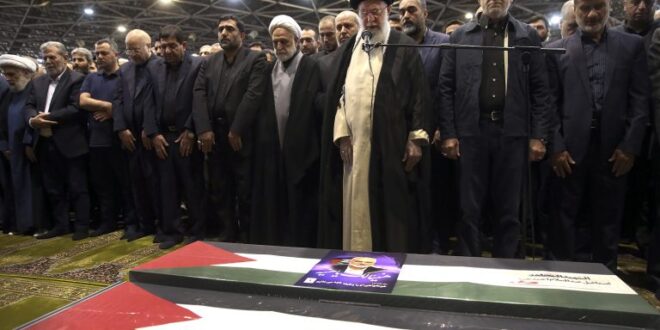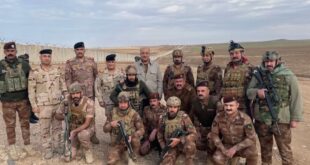Bottom Line Up Front
- Iran and its allies in the “Axis of Resistance” likely perceive recent Israeli attacks as an escalation designed to provoke a broader regional confrontation on Israel’s terms.
- Iran is likely to launch missiles and armed drones at Israel, aiming to cause extensive damage, in contrast to its April barrage that was mostly intercepted.
- Iran’s most potent partner, Lebanese Hezbollah, is likely to join any attack in force as a response not only to the Haniyeh killing but also to retaliate for Israel’s Beirut strike last week that killed a top commander, Fuad Shukr.
- U.S. officials are building up forces in the region to signal to Iran that a major attack on Israel risks bringing Iran into an unwanted conflict with the United States, something Tehran also hopes to avoid.
Iran and its allies in the “Axis of Resistance” likely perceive recent Israeli attacks as an escalation designed to provoke a broader regional confrontation on Israel’s terms. This confrontation aims either to draw Iran into a direct conflict with Israel, which Israeli Prime Minister Benjamin Netanyahu hopes will also prompt further U.S. involvement, or to force Iran and its proxies to retreat, thereby reestablishing the regional deterrence Israel enjoyed before October 7. Thus far, Iran and its proxies have avoided an impulsive response to the Israeli attacks, including those that killed Hezbollah’s top military commander Fuad Shukr in Beirut and Hamas political leader Ismail Haniyeh at an Islamic Revolutionary Guard Corps (IRGC)-run guest house in Tehran. Indications suggest that retaliation from Iran and Hezbollah is forthcoming, with Tehran and its proxies likely promoting these retaliatory attacks as legitimate proportional responses to the recent assassinations in Tehran and Beirut. However, these retaliatory attacks will likely be carefully calibrated in terms of magnitude, and consequences, considering the long-term strategic interests of Iran and its Axis.
Iran and its proxies will likely avoid allowing Israel to exploit a confrontation at a time of its choosing. Instead, the Axis might resume its strategy of attritional conflict, maintaining sustained pressure following its unity of fronts strategy in support of Hamas in Gaza. These support fronts will remain active unless Israel concludes its military operations in Gaza, effectively returning the situation to the pre-assassination status quo. So far, the response from Iran’s Axis suggests an intention to strategically burden Israelis with a period of anticipation and uncertainty. This strategy aims to exploit the anxiety within Israel, amplifying the pressure on its leadership.
When Iran and its Axis allies do launch their response to Israel’s targeted assassination campaign, the region could once again move toward the verge of all-out conflict, a scenario U.S. officials have strenuously sought to prevent since the October 7 Hamas attack on Israel. Iranian and Lebanese Hezbollah leaders have vowed that they and their Axis of Resistance partners will retaliate for Israeli attacks last week. The airstrike on Beirut was stated by Israel to be a response to a rocket attack several days prior, which killed 12 Druze Arab children playing on a soccer field in the Israeli-controlled Golan Heights town of Majdal Shams. The Iran-led threats of significant retaliation come at a time when the Axis of Resistance, although still highly active against Israel, U.S. forces in the region, and commercial shipping in the Red Sea, have suffered some significant setbacks at the hands of Israeli and U.S.-led military operations. In particular, after ten months of war that have disrupted its military infrastructure in Gaza, Hamas is not widely assessed as able to contribute much, if anything, to a coordinated Axis attack on Israel.
Based on Iranian leadership statements, it appears the bulk of the retaliatory strike on Israel is likely to come from Iran itself. The Islamic Republic has sought to demonstrate that Israel cannot cross its “red lines” with impunity. It considers an Israeli operation to kill a major leader of one of its Axis partners, in Tehran, as crossing its red lines. Iran launched more than 300 armed drones and cruise and ballistic missiles at Israel in April in response to an Israeli strike on its diplomatic facility in Damascus that killed several top IRGC commanders assisting Hezbollah and the regime of Syrian President Bashar al-Assad. However, U.S. leaders of Central Command (CENTCOM) assembled a coalition of moderate Arab states, including Jordan and Saudi Arabia, that helped CENTCOM and the Israelis intercept almost the entire missile and drone barrage. The attack caused one Israeli death and little damage to military or other Israeli infrastructure.
A wide variety of press reporting indicates that Iranian leaders intend to increase the scope of their assault beyond that launched in April – to ensure they can overwhelm Israeli and U.S.-led defensive action and cause significant damage in Israel. Some experts postulate Iran might conduct a cyber-attack synchronized with a missile and drone barrage. Israeli experts have warned publicly that if Israelis notice that their phone service or Internet signal is disrupted, they should treat it as a red alarm and stay near shelters. Iranian leaders likely calculate that another barrage that is almost entirely intercepted would raise significant questions about the quality and extent of Iran’s strategic capabilities and potentially weaken Tehran’s hand in the region. Concerns about interception might potentially cause Iran’s leaders to limit the scope of their attack in order to, as they did in April, later downplay the lethal intent of the strike. It could also be coordinated with Hezbollah to pose challenges to Israel’s missile defense system.
A significant Israeli and U.S. concern is that Hezbollah will launch an all-out missile and drone strike as part of the Iran-led attack. Israel has been striking Hezbollah commanders in Lebanon and Syria and Hezbollah military targets consistently since October 8, when Hezbollah began shelling Israel border towns to tie down Israel Defense Forces (IDF) units in northern Israel. Hezbollah sought to draw the IDF away from its Gaza offensive against Hamas. Although Israel’s attacks have damaged Hezbollah’s military infrastructure, the group is believed to still possess more than 150,000 rockets and missiles of various ranges and capabilities. No experts doubt that Hezbollah might potentially overwhelm Israeli defenses and cause massive damage inside Israel.
Other Axis partners, particularly the Houthis in Yemen and Iran-backed Shia militias in Iraq, are somewhat far from Israel, and their ability to contribute significantly to an Iran-led coordinated attack is uncertain. The Houthis did succeed in mid-July in launching a drone attack on Tel Aviv that penetrated Israeli airspace undetected and killed one person and injured eight. However, Israel responded with a disproportionate strike on energy infrastructure in the Houthi-run port of Hodeidah, seemingly deterring the Houthis from attempting additional attacks on Israel. Earlier, Houthi drones and missiles were either intercepted or landed harmlessly in southern Israel, near the Red Sea port of Eilat. The Houthis have, however, persisted in attacking commercial shipping in the Red Sea. Additionally, they may employ missile and drone attacks on bases and facilities in the region that might support CENTCOM-led defensive actions on behalf of Israel.
Iraqi factions, which also operate in Syria, retain the ability to attack some of the 2,000 U.S. military personnel in Iraq and nearly 1,000 still in Syria. However, CENTCOM preventive and retaliatory attacks, including targeted strikes on militia commanders in Baghdad, seem to have deterred these groups from escalating their operations. The stated intent of the government of Iraqi Prime Minister Mohammad Shia al-Sudani to remain aligned with the United States serves as an additional deterrent for Iran-backed groups in Iraq and Syria to contribute any more than symbolic amounts of firepower to a coordinated Iran-led strike on Israel.
For both Iran and any of the Axis partners, a prime factor in their deliberations on the scale of a retaliatory attack on Israel is the potential to trigger a significant conflict with the United States. Avoiding a war with the United States and a U.S. attack on Iranian territory has been a hallmark of Iranian Supreme Leader Ali Khamenei’s rule since he ascended to his position in 1989. Hezbollah has similar considerations while also worrying about the potential for Israel to destroy much of Lebanon and Hezbollah’s infrastructure. After the October 7 Hamas attack, Hezbollah’s leader Hassan Nasrallah, in a major speech, publicly admitted he was deterred from escalating missile and rocket attacks on Israel because of the potential for U.S. forces to retaliate on Israel’s behalf either against Hezbollah, Iran, or both.
In the current context, Nasrallah has stated publicly that Hezbollah needs to respond to Israel’s killing of Fuad Shukr not only with anger but also with wisdom – a clear indication he is factoring in the potential consequences of Israeli and/or American responses to a major Hezbollah barrage. The apparent Iranian and Hezbollah intent to carefully calibrate their actions was evident in reports quoting U.S. and Israeli officials as believing that, as of Saturday, both Iran and Hezbollah were working on finalizing their military plans and approving them at the political level.
For their part, U.S. officials are undertaking significant steps to deter Iranian and Axis leaders from a significant attack. On Friday, Defense Department spokesperson Sabrina Singh issued a statement on behalf of Secretary of Defense Lloyd Austin that: “reiterated that the United States will protect our personnel and interests in the region, including our ironclad commitment to the defense of Israel.” The statement confirmed “adjustments to U.S. military posture designed to improve U.S. force protection, to increase support for the defense of Israel, and to ensure the United States is prepared to respond to various contingencies.” Included in the new deployments are “additional ballistic missile defense-capable cruisers and destroyers.” It increased “readiness” to deploy additional land-based ballistic missile defense. Also ordered was the deployment of an additional U.S. fighter squadron to the region.
To organize a potential defense against an Iranian-led coordinated attack, CENTCOM commander General Michael Kurilla arrived in Israel on Saturday to mobilize the same international and regional coalition assembled to thwart Iran’s April 13 barrage, according to U.S. officials. He is expected to visit Jordan and “several Gulf countries,” according to press reports about his visit. However, U.S. officials also have expressed concern that it might be more difficult to mobilize the same international and regional coalition of countries because Haniyeh’s assassination was viewed in the region as unprovoked and an obstacle to completing an agreement to end the war in Gaza. On Saturday, President Biden reflected on the U.S. uncertainty about its ability to prevent a regional war in answering a reporter’s question about whether he thinks Iran will stand down from a substantial retaliatory strike, saying: “I hope so. I don’t know.”
 Eurasia Press & News
Eurasia Press & News



